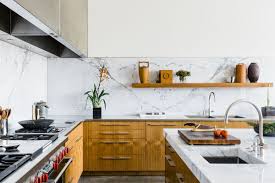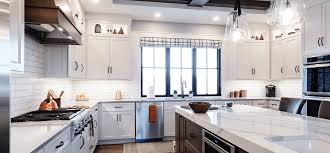What kitchen designers should not do?
Don’t make these common kitchen design mistakes when remodeling your home.
Kitchens are the most used room in the house and the most popular to renovate. A kitchen remodel is a great investment, and it pays off by improving function and boosting your home’s value. It’s easy to get wrapped up dreaming about colors, selections, and other design esthetics, but it’s extremely important not to put finishes before a function. When your design is well planned and thought out you can avoid making common kitchen design mistakes.
Here are some of the most common kitchen design mistakes that are made.
Kitchen Triangle Obstructions
Kitchen design professionals refer to the sink, stove and refrigerator as the kitchen triangle. It’s the area of greatest activity, so designing a kitchen triangle requires careful planning and unobstructed access. Of the three, the sink typically sees the most action, though your triangle should also have easy access to the stove and refrigerator, as well as your countertop workstations.Obviously, your sink needs to be near the plumbing. Sometimes, because of the placement of the pipes, kitchens are designed with the sinks in a poor location. If this is the case in your kitchen, consider hiring a plumber to relocate the plumbing to accommodate the best placement for the sink.Regardless of your kitchen’s size or layout (L-shaped, galley, U-shaped or island), the sum of all the legs in a work triangle should not be less than 10 feet or greater than 25 feet. If the work triangle is too small, people will be tripping over each other. If it’s too large, food preparation could be a tiring task.
Wasted Storage Space
Kitchens typically contain lots of stuff. Not only that, but items concealed behind kitchen cabinets can be oddly shaped and require extra space — think food processors or stand mixers. Finding a home for your appliances while keeping them easily accessible can be tricky.Because built-ins are expensive and the overall size of the area may be limited, one big design mistake is not including enough storage. Even small kitchens have wasted space, but this can be minimized with smart kitchen renovation planning.If your kitchen is small, consider installing extra-long upper cabinets with molding for extra storage space. Place lighting or greenery along the molding to draw the eyes up. Always install cabinets over the refrigerator. Not utilizing this area is a waste of storage space for large or seasonal kitchen items. Finally, install shelves across the backs of the lower kitchen cabinet. This could add up to 4 square feet of extra kitchen storage space.

Ordering wrong size appliances & cabinets
One of the most common kitchen design mistakes is ordering wrong size appliances and cabinets. Oversized or undersized refrigerators, dishwashers, ovens, overhead cabinets, microwaves – you name it, it’s happened too often. In order to avoid these mistakes, measure the space properly and choose the appliances well in advance. Then double and triple-check the dimensions to make sure everything fits in the kitchen layout. Don’t forget to account for when these appliances are in use, i.e., when refrigerator, oven and cabinet doors are fully open.
Not utilizing vertical space
Another kitchen design mistake that can easily be avoided is not maximizing on vertical space, especially in smaller kitchens. Vertical space can provide valuable storage for your client, and wasting that space will create a dysfunctional kitchen.
You can install overhead cabinets or open shelves to give your client a little more room for storage. Make sure the cabinets and shelves reach all the way to the ceiling instead of leaving unusable space at the top. You can even mix closed cabinets with open shelves to add visual interest in the kitchen.

Not planning for a pantry
If you have plenty of vacant overhead space, plan a tall pantry cupboard into your kitchen design. A popular fixture in kitchens of yesteryear, these storage solutions for dried and preserved foods are a great way to keep your long-term supplies organised. Don’t have room for a walk-in space? A pull-out pantry can work just as well.
Not knocking through
Before you start redesigning your compact galley kitchen, take a look at your property’s layout – perhaps your kitchen is flanked by a rarely used dining room or small living area. By knocking through, you could create a large, social open-plan space that would get much more use. As some walls may be structural, be sure to seek professional advice for your project.

Not setting up a temp
If you’re planning to stay in your home while your kitchen is being renovated, you’ll need somewhere to prepare meals in the meantime. You might get away with a fridge, kettle and microwave for a few weeks, but if the work is going to take months, it could be worth investing in a camping stove and asking your builder to temporarily plumb in the dishwasher and washing machine in another room.
Picking poor quality paint
Using bold colour combinations in the kitchen can create a real impact. However, before you pick up the paintbrush, it’s important to make sure that the product you choose is resilient to the daily wear and tear that culinary spaces endure. Look for specialist paints that are resistant to grease and will withstand regular washing and wiping,
Not making room for rubbish
Don’t forget to plan a place for your waste disposal. A built-in bin that recesses inside your cabinetry is a great way to keep unpleasant smells at bay, whilst taking up less floor space than a pedal bin. Opting for a segmented model will make your life much easier when it comes to separating out general waste from recycling too.
Trying to fit too much in
When you’re planning your dream kitchen, it can be tempting to try to squeeze in every last luxury. But before you splash out on a statement island unit or an American-style fridge-freezer, plan your traffic flow to make sure you’ll definitely be left with enough room to manoeuvre. For example, when placing units and appliances opposite one another, allow four feet of space in between to permit doors to open and people to pass.